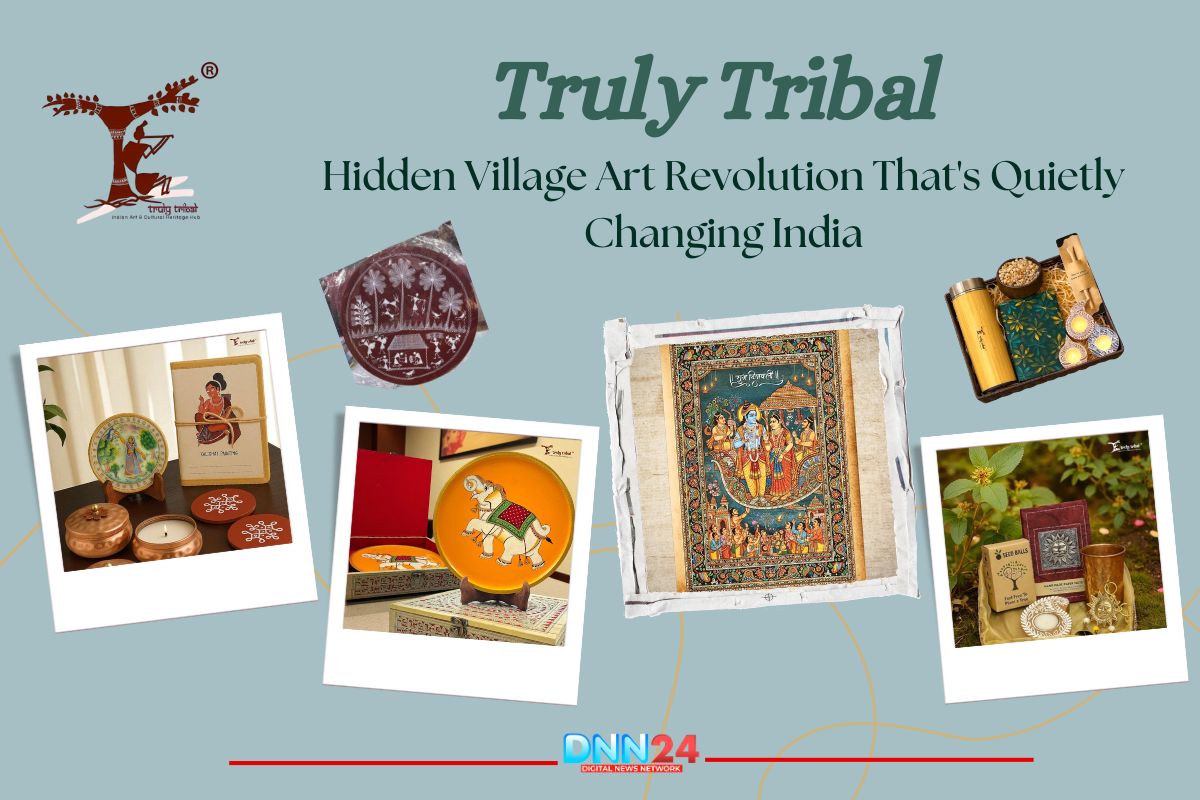Truly Tribal stands where forgotten village artists find their voice again, where ancient patterns meet modern walls, and where India’s fading art traditions discover they can still breathe, grow, and matter. This is not a showroom with price tags and polished floors. Instead, you find yourself surrounded by colours that seem to breathe, patterns that whisper old secrets, and textures that carry the warmth of human touch. Each corner holds something unexpected, a Gond painting where tigers prowl through geometric forests, Warli figures frozen mid-dance on terracotta pots, embroidered cloth that catches light like scattered jewels.
But these objects are not simply decorative. They are survivors. Behind every brushstroke and bead lies a story of struggle, of families choosing between tradition and survival, of artists who nearly walked away forever. Truly Tribal exists because someone refused to let these stories end. This place represents something larger than commerce or craft. It stands as proof that India’s oldest artistic traditions can not only survive the modern age but also thrive within it, provided someone cares enough to listen, learn, and act with genuine purpose rather than shallow sentiment.
Truly Tribal:The Founder Nobody Talks About
The person who built Truly Tribal remains unknown, mainly outside small circles of artisans and craft enthusiasts. This founder grew up in central India, in a village where paved roads arrived late and electricity remained unreliable even later. Childhood there meant watching women gather under neem trees, needles flashing as they embroidered stories into fabric. It meant listening to grandmothers paint mud walls while reciting folk tales passed down through countless generations. Beauty existed everywhere, woven into daily life so thoroughly that most people barely noticed it. But the founder noticed. More importantly, the founder also witnessed something troubling.
Talented artists were abandoning their work. Skilled painters took jobs carrying bricks at construction sites. Embroiderers who once filled entire rooms with their creations now stood idle, their hands growing stiff from disuse. The village elders spoke quietly about traditions dying, about young people fleeing to cities, about art forms that would vanish when the current generation passed away. After finishing college, the founder made an unusual choice. Instead of joining friends in corporate offices or comfortable urban jobs, this individual travelled between remote villages, meeting artists in their homes, listening to their frustrations and fears.
One particular monsoon brought a turning point. Heavy rains destroyed the home of a mud-painting artist, washing away both shelter and livelihood in a single night. The founder spent days helping that family rebuild, not just their house but their hope. During those long hours of labour and conversation, the actual depth of the crisis became clear. These artists did not lack skill or dedication. They lacked access, recognition, and basic economic security. Truly Tribal emerged from that realisation, not as a business plan but as a moral obligation.
Truly Tribal:When Art Becomes Survival
Honestly, Tribal operates with a mission that sounds simple but proves extraordinarily difficult in practice. The organisation aims to restore dignity to Indian tribal arts, create sustainable income for artisans, and preserve cultural heritage before it disappears entirely. This work involves constant navigation between opposing forces. Traditional communities sometimes view outside intervention with suspicion, fearing that outsiders will steal their designs or dilute their artistic integrity. Markets often undervalue handmade goods, comparing them unfavourably to mass-produced alternatives. Buyers want authenticity but also convenience and modern aesthetics. Artists need both immediate income and long-term stability. The founder and team faced countless obstacles. Sales dropped during economic downturns.
Exhibitions flopped. Investors questioned the viability of supporting small-scale artisans in an age of factory production. There were months when the team could barely pay rent, yet they continued to run workshops for artists, invest in materials, and organise showcases, even when profits seemed impossibly distant. One breakthrough came through collaboration with Bhil painters who had never displayed their work beyond their own district. These artists possessed remarkable talent but no experience with formal exhibitions or sales. The founder worked with them for weeks, building confidence, explaining how to present their work, and helping them understand their own value.
When the exhibition finally opened, the artists stood nervously beside their paintings, unsure whether anyone would appreciate what they had created. The response exceeded all expectations. Buyers recognised genuine artistry when they saw it. Sales followed, then commissions, requests for more. Those artists used their earnings to send children to school, repair homes, and continue creating. That single exhibition proved that the model could work, that connecting talented artists with appreciative audiences could transform lives on both sides of the transaction.
Truly Tribal:Traditional Wearing Modern Clothes
Inside Truly Tribal today, you witness an ongoing conversation between past and present. Gond paintings retain their traditional forest imagery but are now displayed on contemporary canvases, making them suitable for urban apartments. Warli art maintains its ancient geometric precision while exploring new themes beyond wedding rituals and harvest celebrations. Embroidery incorporates centuries-old patterns alongside experimental designs that appeal to younger buyers. This fusion requires careful negotiation. Artists must feel respected, not exploited.
Their signature styles need protection even as they evolve. The team at Truly Tribal spends considerable time with each artist, discussing possibilities, suggesting variations, and ensuring that any changes feel organic rather than imposed. The process resembles translation more than transformation, as it seeks to convey timeless ideas in languages that modern audiences can understand without compromising essential meaning. The organisation also explores new materials and techniques. Recycled paper replaces imported stock. Natural dyes sourced from local plants replace synthetic alternatives. Some artists experiment with digital tools, discovering that tablets and styluses can complement rather than replace traditional brushes and pigments.
Each innovation requires patience and trust. Artists need assurance that experimentation will not compromise their artistic identity or economic security. One memorable example involves a tribal woman who nearly abandoned art entirely after her husband died. Financial pressure pushed her toward restaurant work in a distant city. Truly Tribal offered an alternative to traditional work, with steady employment, fair payment, creative freedom, and community support. She accepted. Today, her embroidery appears in homes across multiple continents. More importantly, she rediscovered purpose and pride. Her signature style embodies her personal story, visible to anyone who looks closely enough to see the grief, resilience, and hope woven into every piece.
Truly Tribal:Building Something Bigger Than Business
Truly Tribal functions as a social enterprise rather than a conventional retail operation. Profit matters, but only as a means toward larger goals. The objective measure of success appears in school fees paid, homes repaired, festivals revived, and skills preserved. Artisans from numerous regions now have access to markets that were previously unreachable. Their work is rewarded with fair compensation and genuine appreciation. Their stories get told in ways that honour complexity rather than reducing individuals to picturesque stereotypes. The organisation runs regular workshops where artists learn business skills alongside creative techniques.
They discover how to photograph their work effectively, write compelling descriptions, understand pricing structures, and negotiate with buyers. This education proves crucial because it transforms artisans from passive suppliers into active participants who control their own economic destinies. Truly Tribal also cultivates relationships with corporate clients, interior designers, and international buyers; these connections open doors for commissions, collaborations, and exposure that individual artists could never achieve alone. The organisation handles logistics, quality control, and customer service, allowing artists to focus on what they do best, creating exceptional work.
One elderly artist stands out in the founder’s memory. This man had stopped painting years earlier, convinced that nobody cared about his art anymore. After much persuasion, he agreed to try again. His paintings eventually appeared in an international home décor magazine. When he learned that people in distant countries were discussing his work, studying his techniques, and displaying his art in their homes, he wept. His words became the organisation’s unofficial motto: “My art travels; my story matters.” That sentence now hangs framed in the studio, a daily reminder of why this work matters beyond financial metrics.
Truly Tribal:The Sunrise After Long Darkness
Truly Tribal represents something rare in modern India, a successful synthesis of tradition and innovation, commerce and compassion, individual talent and collective support. The organisation proves that ancient art forms need not fade into museums or history books. With proper support, these traditions can flourish as living practices that evolve while retaining their essence. Walking through Truly Tribal feels different from visiting ordinary craft stores. The atmosphere carries weight, a sense of significance that goes beyond aesthetic appreciation. Each object connects you to specific individuals: the woman who embroidered this cloth. At the same time, her children played nearby.
The man who painted this canvas in his village home between farming seasons, and the family that carved this wooden sculpture using techniques passed down through seven generations. These connections matter. They transform shopping from a transaction into a relationship, from consumption into a meaningful and enduring participation. The founder’s journey from village observer to organisational leader demonstrates what becomes possible when empathy meets determination. One person’s refusal to accept defeat sparked a movement that now sustains hundreds of families and preserves cultural treasures that might otherwise have vanished.
This story, told here without exaggeration or artificial drama, offers genuine inspiration. It shows that careful attention to human needs, respect for traditional knowledge, and willingness to work patiently through obstacles can produce extraordinary results. Truly Tribal invites everyone to participate in this ongoing story, not as passive consumers but as active supporters of living traditions. Every purchase provides income that changes lives. Every conversation spreads awareness that challenges and breaks down stereotypes. Every exhibition creates opportunities that might not otherwise exist. The tribal arts of India were on the verge of extinction.
Today, thanks mainly to efforts like those of Truly Tribal, these traditions experience a genuine renaissance. Artists who once hid their skills now display them proudly. Young people who might have abandoned ancestral crafts instead study them seriously. Villages that seemed destined for cultural erasure now buzz with creative energy. This transformation did not happen accidentally. It required vision, labour, sacrifice, and stubborn faith that art matters, that culture matters, that people matter more than profits or convenience. Truly Tribal embodies that faith. Its existence proves that even in our fast-moving, mass-produced modern world, there remains space for slow craftsmanship, individual artistry, and stories told through patient, careful, human hands.
Also Read: Pad Squad: Spreading Menstrual Dignity Across India’s Communities
You can connect with DNN24 on Facebook, Twitter, and Instagram and subscribe to our YouTube channel.

